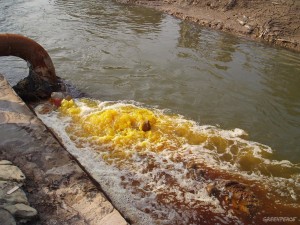A decent sewer system is one of the most important infrastructure elements of a city without which civilised, healthy living and protection from flooding is just not possible.
 Modern populations demand flushing toilets, regular showers, washing machines and pleasant, well-watered gardens and parks. Not all of these functions require water that is treated to drinking standards, transported into the city, then collected and transported back out of the city as wastewater. For some major water uses, treated wastewater effluent can be re-used, reducing the overall water requirement by about 30 per cent.
Modern populations demand flushing toilets, regular showers, washing machines and pleasant, well-watered gardens and parks. Not all of these functions require water that is treated to drinking standards, transported into the city, then collected and transported back out of the city as wastewater. For some major water uses, treated wastewater effluent can be re-used, reducing the overall water requirement by about 30 per cent.
In areas where water resources are scarce, water use needs to be optimised, but the possibilities for achieving greater efficiency with centralised systems are limited by costs. The solution is decentralise networks and reuse water at a local level. ‘Waste’ water needs to be seen as a resource instead of an environmental problem. With wastewater treated at a community level the effluent can be piped back short distances to the ‘source’ buildings for toilet flushing, while a part can be stored and used for irrigating green areas.
The organic components of wastewater are also a potentially useful resource, as they degrade they can release biogas as an energy source and residuals can be incinerated to release energy. These biosolids can also be a source of phosphorous and nitrogen which, if suitably processed, can be a useful soil fertiliser and conditioner.
Such decentralised wastewater treatment and reuse requires additional infrastructure and operational expenditure at the level of the local community but there are wider savings from reduced infrastructure loading on the city-wide water supply and wastewater collection and treatment systems. These regional savings can help to offset some of the additional local costs.
Recent advances from Europe that could be applied in China to minimise risks of flooding and pollution from overflow spills to rivers. These highly efficient solutions start with the use of computer models to analyse and optimise investments in the drainage network. Real-time controls can actively operate gates and storage tanks in response to weather conditions by feeding rainfall radar data to the model and predicting the best configuration of the system to respond to the conditions and maximise capacity.
The capacity and reliability of existing sewers can also be increased by regular flushing to remove sediments and blockages. This is normally an inconvenient and unpleasant task, but with the installation of automatic tipping gates in the sewers a portion of the flow can be held back and then released in one go to send out a regular wave to clear the system. This is particularly relevant in China where the design codes for sewers allow for relatively shallow gradients.
Another major change in Europe in recent years has been the application of sustainable urban drainage systems (SUDS). These work on the principle of source control, reducing the speed and amount of water flowing into the sewers and so attenuating the flood peaks. Instead of using impermeable hard concrete and tarmac for car parks and squares, permeable paving, green roofs and soakaways, and green-grassed channels leading to urban ponds and wetlands can be employed to allow water to seep back into the soil. Together these advanced water and drainage management solutions can be used to build more efficient, more aesthetically pleasing and more sustainable cities to live in.
By Simon Spooner
Simon Spooner is the Technical Director at Atkins Water & Environment and Chair of the European Chamber’s Beijing Water Working Group.


Recent Comments